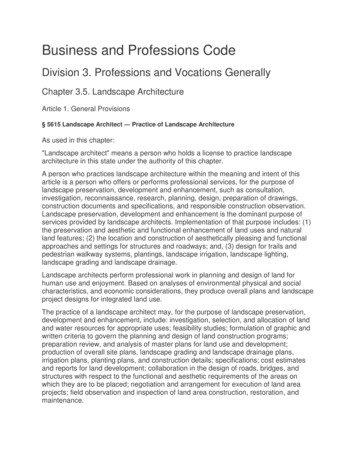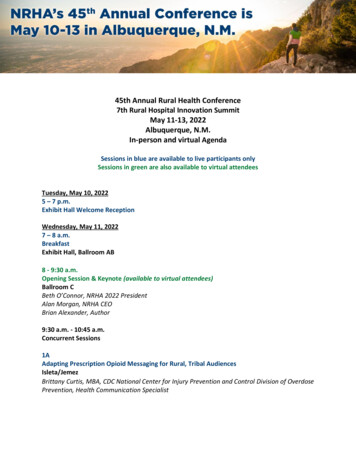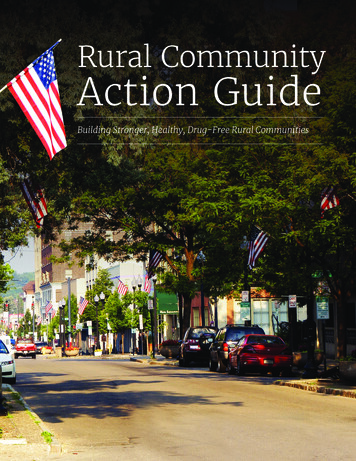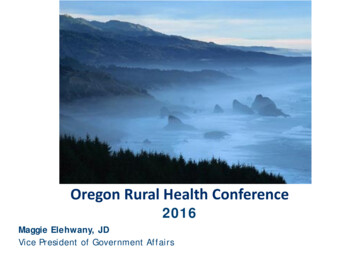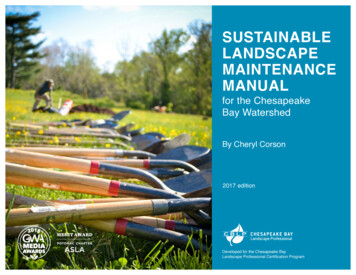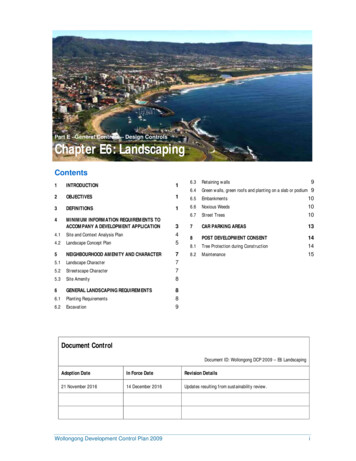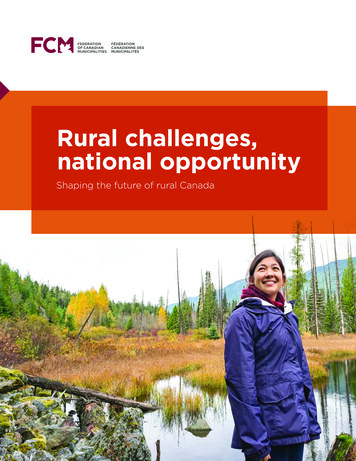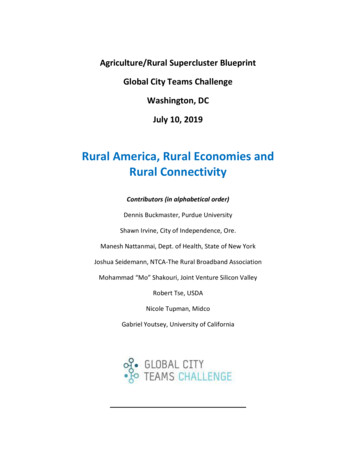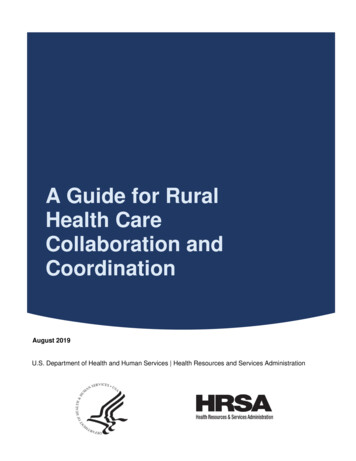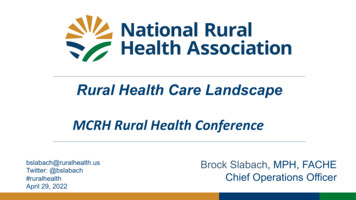
Transcription
Rural Health Care LandscapeMCRH Rural Health Conferencebslabach@ruralhealth.usTwitter: @bslabach#ruralhealthApril 29, 2022Brock Slabach, MPH, FACHEChief Operations Officer
Our mission is to provideleadership on rural health issues.
3
Destination NRHAPlan now to attend these 2022 events.Annual ConferenceMay 10-13, 2022Albuquerque, NMRural Hospital Innovation SummitMay 10-13, 2022Albuquerque, NMRural Health Clinic ConferenceSept. 20-21, 2022Kansas City, MOCritical Access Hospital ConferenceSept. 21-23, 2022Kansas City, MOVisit RuralHealthWeb.orgfor details and discounts.4
Agenda
Today’s Presentation The Rural Landscape COVID-19 Federal Update Innovation QuestionsGo Rural!
The Rural Landscape
What We Fight for on Behalf of Rural Addressing RuralDeclining LifeExpectancy andInequality Reducing RuralHealthcare WorkforceShortagesAddressing RuralDeclining LifeExpectancy andInequality Invest in a Strong RuralHealth Safety NetReducing RuralHealthcare WorkforceShortages Invest in a Strong RuralHealth Safety Net
Rural DetailsRural areas make up 80% of the land mass in USARural areas have roughly 17% of the US PopulationRural areas provide the food, fuel and fiber to powerour nationAccess to high-quality health care is a requirementto keep these important resources availableAn exchange between urban and rural that must notbe overlookedHistorically, public policy has disadvantaged healthcare in rural communities
Asset-Based Look at Rural AreasSource: Urban Institute
“Rural hospitals and the ruraleconomy rise and fall together” On average, 14% of total employment in ruralareas is attributed to the health sector. Natl.Center for Rural Health Works. (RHW)“Three years after arural hospital communitycloses, it costs about 1000 in per capitaincome.” The average CAH creates 107 jobs andgenerates 4.8 million in payroll annually.(RHW) Mark Holmes, professor,University of North Carolina Health care often represent up to 20 percentof a rural community's employment andincome. (RHW) Medical deserts form in rural communitieswhere hospitals close.
Rural Realities Asset-based approach for rural communities Health Care is vital to rural communities for two reasons: Access to care Economic Development Rural communities are challenged: Public policy disadvantages: one-size fits all Covid has expanded the fractures that pre-existed in rural areas Policy solutions must account for the complexities of ruralcommunities, recognizing the value of health care
Convergence of Multiple Pressure PointsHealth DisparitiesPopulation MigrationRecruitment/Retention 2022 The Chartis Group, LLC. All Rights Reserved.Healthcare PoliciesEconomic PolicyCOVID-19Page 13
Population Health DisparityRural v. UrbanPercentile Ranking69Rural636963623332Access toPrimary CareAccess toMental Health413233UrbanOver 65 2022 The Chartis Group, LLC. All Rights Reserved.DiabetesMedian HSHLDIncomePage 14
Population Health DisparityRural v. UrbanPercentile rematureDeathUrbanMedian HSHLDIncome 2022 The Chartis Group, LLC. All Rights Reserved.ChildPovertyUninsuredAdultPage 15
Rural Hospitals Vulnerable to SALGASC453FL01%—9%10%—15%16%—20%21%—25% 26%—30% 31%—40%41% Medicaid Expansion StatePercentage of State Rural Hospitals Determined to be Vulnerable 2022 The Chartis Group, LLC. All Rights Reserved.Page 16
Hospital Performance By State Chartis Center for Rural Health has compiled a list of hospitalsnationwide and thee impact that various payment programshave on performance. Link here to access this valuable data.
Where the Safety Net is WeakestVulnerable Rural Communities v. RuralPercentile Ranking73Vulnerable enPrematureDeathRuralPrimary Care 2022 The Chartis Group, LLC. All Rights Reserved.Mental HealthUninsuredAdultPage 18
Rural Population DisparityAdults MSALGASCFLPercentage of population served by rural hospitals thatis adults under age 65 without health insurance.6%-10%NHWAHI0-5%VT16%-20% 21%-25% 25%Medicaid Expansion State 2022 The Chartis Group, LLC. All Rights Reserved.Page 19
Rural Population DisparityChild ALGASCPercentage of population served by rural hospitalsthat is under age 18 in poverty.6%-10%NHWAHI0-5%VT16%-20% 21%-25%FL 25%Medicaid Expansion State 2022 The Chartis Group, LLC. All Rights Reserved.Page 20
The Geography of Food Stamps
Disparities in Maternal Care Access for Rural Moms
Prevalence of Medicare Patients with 6 or more ChronicConditions
The Digital Divide in Rural America
Red Sky in Morning, Sailor’s WarningNegativeOperating MarginMedicareSequesterPAYGORural HospitalStaffing45% 228.5M 900M 96.2%Excluding relief funds2% cut July-Dec 20224% cut 2023said nursing #1 need 2022 The Chartis Group, LLC. All Rights Reserved.Page 25
How Unstable is the Rural Health Safety Net?Operating Margin, Closures and Hospital Vulnerability 12.9B41%2Pandemic ReliefPayments*Operating in the Red(includes relief funds)Rural HospitalsClosed in 2021*CARES Act and CAAP 2022 The Chartis Group, LLC. All Rights Reserved.Page 26
Pandemic Relief Funds Stabilize Safety Net 2022 The Chartis Group, LLC. All Rights Reserved.CARES ActMedicareAdvanced Payments 4.8B 8.2BAmericanRescue Plan 887MPage 27
Addressing COVID-19
COVID-19 New Infection RatesApril 17, 2022Source: Daily Yonder COVID-19 Dashboard, 2022.
Covid Hospitalization Rate by CountySource: NY Times April 19, 2022
Covid Hospitalization Rate by CountySource: NY Times, Jan. 24, 2022
Rural COVID-19 Death RateAs of April 13, 2022Source:. CDC and selceted state departments of or-rural-america/
Vaccination Rates in USSource: NY Times April 18, 2022
NRHA survey shows rural COVIDvaccine barriers, needs Most rural adults report at least partial vaccination for COVID-19 (61%), aswell as half of rural parents (47%) and rural teens (48%) Overall, 31% of rural adults, 42% of rural parents, and 50% of rural teensreport feeling social pressure about the vaccine – either to accept it orreject it. When looking at barriers to vaccination, feeling overwhelmed by theinformation and misinformation is the most selected barrier to personalvaccination uptake (26% of unvaccinated rural adults) and vaccinationuptake for their child(ren) (31% of rural parents) Health care providers are the most trusted source of COVID-19 vaccineinformation across all three groups: rural adults, parents, and teens
Provider Relief Fund & ARP Rural Fund HRSA has made more than 13.5 billion in Provider Relief Fund Phase 4General Distribution payments to more than 86,000 provider across the country. In addition to the American Rescue Plan, rural payments totaling nearly 7.5billion in funding to more than 44,000 providers since November 2021. HHS released an updated state-by-state table outlining all Phase 4 paymentsmade to date.Michigan2,632 Providers 354,568,600 in Total Payments Pay attention to reporting requirements at the PRF Reporting webpage!
Rural Vaccine Confidence:Key Messages Sharing THE FACTS: safe, effective, freeof charge, development Protecting LOCAL BUSINESSES whilestrengthening economy: local healthcareworks, keeping workers safe, stay open Protecting YOURSELF:hospitalizations/death, personal choiceNRHA: COVID-19 Vaccine Talking Points
COVID-19 Resources NRHA COVID-19 Vaccine Resources NRHA COVID-19 Rural HealthProvision Summary NRHA COVID-19 TechnicalAssistance Center NRHA COVID-19 Resources Page We Can Do This COVID-19 PublicEducation Campaign
Federal Update
Drivers behind rural workforceshortage COVID-19 burnout/exhaustion Baby Boomers are retiring Desire for flexible work schedules New options like remote work/digital opportunities Salary and benefit limitations Education opportunities limited Rural patients need more services Rural practice characteristics Rural communities lack spouse opportunities
Rural Health Workforce1. Expand the Medicare Graduate Medical Education (GME) Program NRHA urges support for S. 1893, the Rural Physician Workforce Production Act, to ensure rural providers areadequately represented in the Medicare GME program.2. Provide supplemental appropriations to National Health ServiceCorps Support supplemental appropriation funding for workforce programs like the National Health Service Corps andthe Nurse Corps Loan Repayment Programs in future COVID-19 relief legislation.3. Support the nursing workforce to expand access to care NRHA urges support for S. 246 / H.R. 851, the Future Advancement of Academic Nursing (FAAN) Act.
National Health Service Corps 2022 National Health Service Corps (NHSC) New Site ApplicationCycle is now open New site application due through May 5, 7:30 p.m. ET Opportunity is for sites that have never been approved for NHSC! Potential eligible rural sites eligible include Rural Health Clinics, CriticalAccess Hospitals, Federally-Qualified Health Centers (and look-alikes),Community Mental Health Centers, and State or Local HealthDepartments Interested sites and treatment facilities should review the Site ReferenceGuide (SRG) for additional details on becoming NHSC approved. HRSA will be holding free webinars to help with the application process. April 27, 12-2 p.m. ET: NHSC New Site Application Q&A Session #2
FY 2023 IPPS Rule Released Increase of 3.2% to PPS rate Designation of “Birthing Friendly” Hospitals 1,786 pages long Link here to access the NPRM NRHA will provide a summary once complete
MDH and LVH Reauthorization Medicare Dependent Hospital and Low Volume Hospitalprogram authorization expires September 30, 2022 NRHA is advocating for reauthorization of these two programs Critical lifeline for small rural PPS hospitals to offset harmfuleffects of prospective payments on low volume hospitals
H.R. 6400, Save America's Rural Hospitals ActIn January, Representatives Graves (R-MO) and Huffman (D-CA) introduced theSave America's Rural Hospitals Act which included several of NRHA’s ruralhospital and rural health clinic priorities. Sec. 114: Restore full CBR AIR in exchange for reporting requirements forprovider-based RHCs. Sec. 101: Elimination of Medicare sequestration for rural providers. Sec. 111: Makes permanent increased payments for ground ambulances. Sec. 113: Makes permanent telehealth distant site status for FQHCs and RHCs. Sec. 401: Reauthorizes the Medicare Rural Hospital Flexibility Program.
Rural Health ClinicsNRHAs advocacy priorities is to modernize and improve the rural health clinic program. Legislation to allow provider-based RHCs to receive reimbursement rates not subject to the upperpayment limit cap in exchange for quality reporting measures. This proposal is reflected in NRHA's updated rural health clinic program modernization fact sheet. NRHA is also advocating Congress permanently extend CARES Act telehealth flexibilities for both RHCsand Federally Qualified Health Centers and allow them to be reimbursed for telehealth services at a ratecloser to their in-person rate.In the long-term, NRHA is working to get legislation introduced to modernize the RHCprogram by: Modernizing staffing requirements to allow for arrangements consistent with state and local law Allowing RHCs the flexibility to contract with physician assistants and nurse practitioners, rather thansolely employment relationships Removing outdated laboratory requirements
Telehealth During COVID-19 CARES Act provided the largest expansion of telehealth flexibilities inhistory for the duration of the public health emergency. The administration, through the 1135 waiver process also enhancedtelehealth access. Current telehealth provisions are tied to 151days past the end of the publichealth emergency. PHE has been extended to July 15, 2022 by Sec.Becerra, telehealth will be extended until December 13, 2022. NRHA is adamant that telehealth provisions be permanently extended andrates increased beyond the duration of the public health emergency so ruralproviders and patients can continue an increased access to care.
340B Program Lifeline Ensure the 340B Drug Pricing Program remains a criticalresource for rural hospitals Attacks on contract pharmaciesMedicare payment cutsPharmacy Benefit Manufacture restrictionsScope of patient definition 340B Program reforms: Protect rural hospitals Increase HRSA’s enforcement authority NRHA urges support for H.R. 4390, the Protect 340B Act of 2021
Medicare Advantage Rural MA enrollmentcontinuing to grow: Enrollment grew by 7.2percent from 2020-2021 CMS does not considerMA to be Medicare forrural cost-base providerpayments, reducingMedicare volume andpayments Solution: Require CMSconsider MA patient daysand outpatient review asMedicare
Mental HealthCongress has held several hearings devoted to the mental health epidemic. Amental health package could possibly pass and provide significant supporttoward these epidemics. The Senate Finance Committee released a bipartisan request forinformation on legislative proposals to that will increase access to health careservices for Americans with mental health and substance use disorders. NRHA is working with Representative Porter (D-CA) and Senator Smith (D-MN)to advance the Stopping the Mental Health Pandemic Act (H.R. 588 / S. 165).The President's fiscal year (FY) 2023 budget request includes several initiatives toaddress the mental health needs of Americans and the opioid epidemic.
Recent Activities NRHA met with CMS/CMMI in a roundtable on rural participation inaccountable care Focus on lessons learned from AIM ACO model integration into MSSP Findings from that discussion can be found here NRHA letter to HRSA regarding HPSA’s proposed for withdrawal Requesting 1) improved transparency, flexibility, and technical support, 2)additional time for redetermination before de-designation occurs A copy of the letter can be found here
FY22 Appropriations & OmnibusIn early March, the House and Senate agreed to fund the governmentfor FY 2022. Included in the package was: USDA 3.45 billion for the Rural Community Facilities Program and 2 millionfor the Rural Hospital Technical Assistance Program 62 million for the Medicare Rural Hospital Flexibility Grant Program. Thisincluded 5 million to establish a Rural Emergency Hospital (REH) TechnicalAssistance Program. The continuation of other core rural health programs, including: 12.5 million for State Office of Rural Health 135 million for the Rural Communities Opioid Response Program 10.5 million for the Rural Residency Development Program 122 million for the National Health Service Corps 6 million for the Rural Maternity and Obstetrics Management Strategies (RMOMS) program
NRHA is Advocating For Extend relief from Medicare sequestration until December 31,2022. Extend telehealth flexibilities beyond the duration of the publichealth emergency, including RHCs, FQHCs, and CAHs. Reinstate uncapped reimbursement for provider-based ruralhealth clinics in exchange for quality measure reporting. Enhance the rural health care workforce. Fully fund the Rural Health Safety Net in FY2023 appropriations.
Innovation
Innovation Insights Traditional fee-for-service payment will wane as we continue transition to valuebased payment Site-neutrality payment policies will continue to proliferate Pressures continue for rural hospitals: Operational efficiencies Human resources/workforce shortages Access to capital Clinical integration will create advantages to systems of accountable care (Valuebased payment, re-admission rates and preventable re-admissions, bundledpayments, accountable care organizations, etc.) Flexibility key to strategy going forward: increased regulatory and environmental uncertaintyLegislative changes, for example, sequestration, Paygo, etc.
Payment Transition Plan: CMS/CMMIGoal: 100% ofMedicare payments toproviders are througha VBP approach
Trends in Rural Accountable Care Accountable Care Organizations (ACO) Pennsylvania Rural Health Model (PaRHM) and Global BudgetEvaluate your organization’s VBP readiness:Rural Health Value Catalogue of ModelsAccountable Health Communities Model –Two Rural Participants’ Experiences
New! Rural EmergencyHospitalClinicLimited hoursNo EmergencyServicesNo Overnight StaysPrimary CareRural Emergency HospitalOpen 24/7Emergency ServicesNo Overnight StaysPrimary CareTelemedicineHospitalOpen 24/7Emergency ServicesOvernight Stays
Key Elements of the REH Model Effective for services as of 1/1/2023 Current CAHs and rural PPS under 50 beds Requires ED staffing levels and transfer rules to Level I or II trauma Payment for services at OPPS amounts plus 5% & monthly facilitypayment Allow distinct-part SNFs Required implementation plan Required quality reporting
Summary The Rural Landscape COVID-19 Federal Update Innovation QuestionsGo Rural!
Questions?
Thank you.bslabach@ruralhealth.us@bslabach#ruralhealth
Destination NRHA Plan now to attend these 2022 events. Annual Conference May 10-13, 2022 Albuquerque, NM Rural Hospital Innovation Summit May 10-13, 2022 Albuquerque, NM Rural Health Clinic Conference Sept. 20-21, 2022 Kansas City, MO Critical Access Hospital Conference Sept. 21-23, 2022 Kansas City, MO 4
